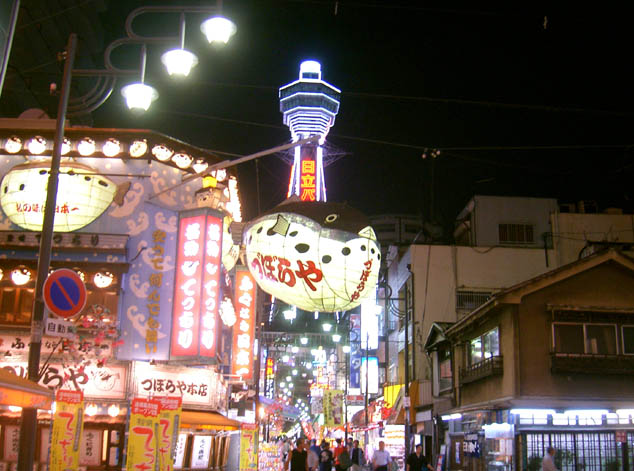October 13, 2004
Kushiyaki in Shinsekai

Shinsekai means "new world", and I can only imagine how striking this area must have been when it was new, a long, long time ago. Giant puffer fish(not called fugu in this area) lounge around a dense arrangement of lights, some street looking Japanese people hanging around, dark alleys cutting between the subdivisions on the block, and attractions reminiscent of carnivals in their heyday. Glare and inky darkness create a dystopic atmosphere in Shinsekai, bringing back snippets of Chinatown, Blade Runner, The Replacement Killers, Idoru (William Gibson), and other Noir works. I wonder how the food was in those world's back alleys- Either Gibson or Stephenson wrote that most of the food available in his Shinsekai-like neighborhood was made of processed krill...
There must be about 10 different joints where they serve kushiyaki (skewered-fried food in the same family as shishkabobs and corndogs, but of different parentage) under the gaze of Tsutenkaku Tower, but the best looking one was the one where all of the locals were waiting to get in, right down this street. A huge counter surrounds the kitchen that runs down the middle of the length of the izakaya. The kushiyaki runs from 80 yen (regular fried pork cutlet and beef tendon- this item isn't kushiyaki- stewed in a miso stew) to just over 200 yen per skewer (for more expensive stuff). You can sample so much for quite a reasonable price. The majority of the kushiyaki are prepared by frying them in panco, the bread crumbs that are used to coat tonkatsu.
It is unusual in Japan to have one of those food experiences where you wonder "Is it safe and sanitary to eat this?" (unlike the typical uninitiated gaijin question "Isn't it supposed to be cooked/ not rotting/ dead when they serve it?"). Japan is typically the land where they will thourally package everything at least four different ways and use disposable wetnaps for every meal. Here, in the kushiyaki joints, the dipping sauce is shared in communal troughs with strangers and friends alike. Pools of swirling oil shimmer on top, and other random detritus can be seen floating, suspended in the collodial middle of the sauces thermoclamatic strata, or felt on the bottom by probing the benthosphere.
Like all wonderful late night culinary adventures, this place is best enjoyed over several mugs of beer. Beer tastes better with kushiyaki, and vice versa. And if you have any urge to satisfy your curiosity regarding something you would usually never eat, the beer will help you to go for it, and also serves as something to wash a bad experience past your mouth and into your gut. Using this very method, I was able to overcome killing, cleaning, and eating a live shrimp that quivered as it was digested inside my stomach, eat pig's feet (the best thing I ate in Okinawa BTW) and other parts of the hog in their recognizable states that are usually reserved for the production of sausage, develop an appreciation for hormone (intestines) and every other type of innard prepared the proper way (I will never like cooked liver or kidneys, ever), and started to crave basashi (horse sashimi), grilled horse meat, and basashi liver. If you are content with eating exclusively out of McDonalds and convenience store food and have a need to use wetnaps before and after every meal, you will probably never understand what I'm talking about.
Oh, and just in case:
*Basashi should be enjoyed by wrapping it in a shiso leaf with paper-thin slices of tamanegi (onion) and dippped into shoyu with shoga (ginger) mixed into it. Wasabi is optional.
*Basashi liver is best enjoyed with paper-thin tamanegi slices dipped into shoyu with a few drops of goma-abura (sesame oil, the reguar stuff), and wasabi is optional.
*Like any other type of food, there is high-quality hormone and low-quality. If you eat bad hormone you will definetely know it, and the same is true of the good stuff because it will taste pretty good.
*Thanks to J for pointing out the mistakes in this entry.
Posted by Adam at October 13, 2004 03:35 PM | TrackBack